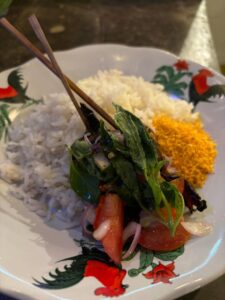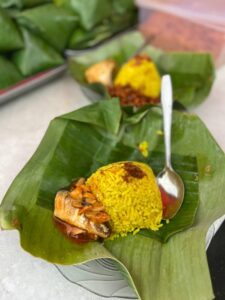How to make Indonesian-style rice dishes

I had the privilege of meeting Ade Putri during my visit to Indonesia. We met at the lovely home of culinary guru and chef William Wongso.
Ade was born and raised in a family that deeply appreciates food. In her younger years, she was encouraged to explore and to savor. This is how Ade’s lifelong passion for food came to be. Her childhood shaped her curiosity for all things culinary.
Many of Ade’s pursuits are centered on food. She cooks, teaches cooking, writes about food, travels for food, creates content on food, hosted a radio show that talks about food, and appears on shows that delve on food. The most notable of her appearances was on “National Geographic’s Uncharted” alongside chef Gordon Ramsay.

Those closest to Ade refer to her fondly as a “culinary storyteller.” When I learned that Ade holds cooking lessons, I asked what Indonesian recipes she thought best to share. She stopped to think and blurted out: Rice!
Rice is easy to cook, its preparation easy to follow and practical, since many Indonesian rice dishes are one-dish meals.
How could I disagree? We Asians, after all, share a love for rice.
William said there’s a phrase that goes, a meal is not complete until you’ve eaten rice, and the best way to eat it is with your fingers!
That said, enjoy these Indonesian rice recipes from Ade.
Nasi Goreng Terasi
Indonesia has numerous types of nasi goreng. It can be made with different spice paste bases. Some would make it from leftovers (leftover rendang, leftover semur). Using cold rice is a must to prevent the nasi goreng from being clumpy. Ade uses leftover rice from the day before. The protein can be anything you like, the most common being egg (sliced omelet or sunny-side up), shredded chicken, or seafood (squid, prawn, or fish balls).
Belachan (Bagoong) Fried Rice
- 300 g cooked white rice, cooled
- 3 shallots
- 2 garlic
- 1 candlenut
- 1 big red chili
- 2 curly red chilies
- ½ tsp terasi (fermented shrimp paste)
- Salt
- Coconut oil
Grind the shallot, garlic, candlenut, chilies, and shrimp paste until smooth.
In a wok, heat the coconut oil. Sauté the ground spice paste until fragrant and cooked.
Add the protein at this point. Cook protein.
Pour the rice and turn up heat to high. Stir well, vigorously.
Nasi goreng is ready to serve.
You may substitute terasi with Thai shrimp paste, and candlenut with macadamia nuts.

Nasi Kelapa
Ade said nasi kelapa is typically from Ambon in Maluku. It is served with grilled fish and colo-colo (condiment made of chili, green tomato, shallot, and lemon juice). Unlike similar rice dishes from other regions that include a lot of other ingredients like bay leaf, lemongrass, etc., this rendition is the lightest and pairs easily with different types of spiced food.
- 4 c white rice
- 3 c water
- 1 c coconut milk
- ½ tsp sea salt
- ½ old coconut, grated
- 2 garlic
- 3 big red chilies
- 1 curly red chili
- 2 cm sand ginger/aromatic ginger (kencur/kaempferia or galangal)
- 1 tsp coriander seed
Cook the rice with coconut milk, water, and salt in a rice cooker until done.
Transfer to a steamer and steam for another 30 minutes to make it fluffier.
Make the serundeng merah: Grind the garlic, chili, sand ginger, and coriander seeds.
In a pan over low heat, cook the grated coconut with the ground spice paste until fragrant and dry. Make sure to stir once in a while to avoid scorching.
Serve the coconut rice with the serundeng merah, roasted grated coconut.

Nasi Kuning
In Java, according to Ade, nasi kuning or aromatic yellow rice is often served in ceremonies as nasi tumpeng (rice is shaped to form a cone, surrounded by an assortment of dishes). It is also enjoyed for breakfast. Most Javanese serve nasi kuning with caramelized tempe called orek tempe, sliced omelet, fried chicken, and sambal, but Ade was quick to disclaim that it is not the serving standard. In Ambon and Ternate (Maluku), they often serve it with spicy shredded skipjack tuna and fried vermicelli.
- 5 c white rice
- 1 pandan leaf
- 3 bay leaves
- 1 lemongrass, smash the white part
- 4 kaffir lime leaves
- 2 c coconut milk
- 4 c water
- 5 shallots
- 3 garlic
- 2 cm turmeric
- ½ tsp sea salt
Grind the shallot, garlic, and turmeric until smooth.
Cook the rice with the ground spice paste and the rest of the ingredients until done. Steam for another 30 minutes to make it fluffier.
Nasi kuning is ready to serve.
Follow @iamreggieaspiras on Facebook and Instagram;reggieaspiras.com


















